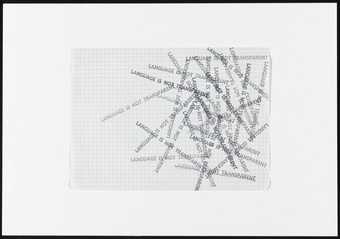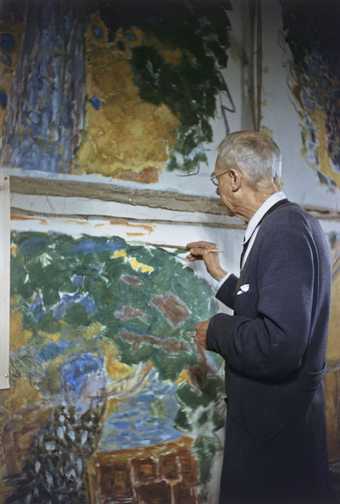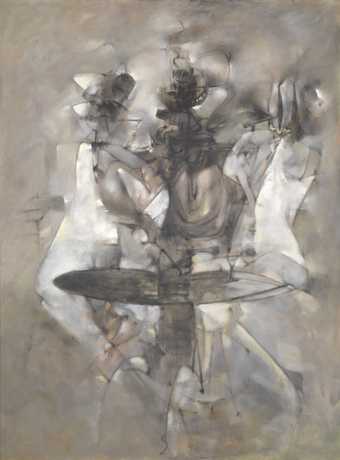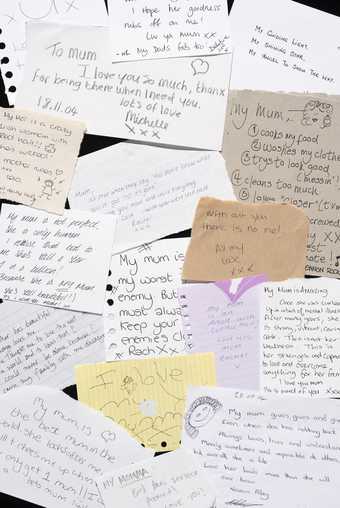
Mel Bochner
Language is not transparent (1969)
Tate
My first impression of Mel Bochner’s Language is not transparent is that he doesn’t really mean what he’s saying. In Bochner’s paintings words are often stacked up in rows, like bricks, or, as in this case, scattered like pick-up sticks. He draws attention to the fact that words have a physical form, a visual presence, as well as a meaning, that when we are reading we are both thinking and looking (and listening, as poets know). Bochner’s interest in the form of words – what words are other than meanings – reminds me of some kinds of poetry like concrete poetry, or poems with odd layouts. But whereas those practices seem to use the non-meaningful dimensions of words to echo, or somehow emphasise, their meanings, the meaningfulness of words in Bochner’s work are always somehow compromised, the relationship between words meanings and images feels more like divorce.
What, anyway, does it mean to be transparent? Glass is transparent (except at night, when a window becomes so opaque that it’s almost a mirror). I am reminded of The Glass Chain, a group of artists, architects and writers who believed that society should embody the principles of glass. But is transparency necessarily a virtue? There is a morality in the idea of transparency: it represents honesty, clarity, openness. But some things are better opaque. I think of the necessity that ideas, secrets, thoughts are concealed, safely in one’s head. I think of the feeling, as a writer, that one is sometimes over-exposing oneself. I remember overhearing a conversation at the architecture practice where I used to work. Transparency may be suitable for a bank, but not for a changing room.
Bochner’s views on transparency are not straightforward either. In this image, anyway, language is transparent. We can see through it. Which is not particularly revealing, since what’s behind it is just itself. Language isn’t complex or obscure or confusing, it’s just boring. It’s just the same thing, then, repeated over and over again, stacked up, pointing in different directions. It’s something messy, haphazard. The words LANGUAGE IS NOT TRANSPARENT seem to have been imprinted with a stamp, an implement which can do nothing but repeat. Though of course, total repetition is impossible. Sometimes the words look darker, clearer, more vivid, more distinct; at others they appear lighter, vaguer, softer, as if fading away. We don’t think of language as having a colour (though vulgar language is sometimes called colourful) but really, since we see it so often it’s ubiquitous, language is black. And so, these differentiated shades of grey – as if the stamp ink were running out, or the artist had stopped bothering to replenish it – seem to echo a sense that the words are becoming somehow degraded. Their fading implies a kind of distance. Not a literal distance (since the words are not getting smaller) but a sense that, with their gradual lightening, they are becoming somehow less here, that they are acquiring an almost dreamlike quality. And perhaps it’s not surprising to discover that a person saying the same thing over and over again would find, after a while, that their words sound somehow strange, and empty.
One does not immediately notice that the words are printed onto a sheet of graph paper. The grid, with neat little boxes – the kind I associate with accounting ledgers and mathematics workbooks – implies the possibility of certainty, of conclusiveness, of transcribing written language into mathematical language, and thereby decoding its secret. A grid is for plotting, measuring, making knowable. What is the grid trying to work out? Whether language is transparent or not, I suppose. There is a tension between the words and the grid. The grid feels an attempt to impose something predictable and coherent onto something incoherent and expressive, as in an Agnes Martin painting, or the way that Manhattan island’s natural topography was flattened to make way for its long, straight avenues, the grid of rectangular buildings on rectangular plots. But, in any case, the words have slipped the matrix and are gathered in a clump on the right-hand side, as if having lost their coordinates, as if the page has been tilted to one side. What are they communicating? That this question of whether language is or isn’t transparent, they seem to be saying, is peripheral (or anyway, not central). Their resistance makes the grid feel less like a grid and more like a net. We want to preserve our opacity, the words seem to be saying, our secretiveness.
Katharine Kilalea is a writer based in London. Her debut novel, OK, MR. FIELD, was published in early June 2018 by Faber & Faber. Her first book of poems, One Eye’d Leigh, was shortlisted for the Costa Poetry Award and longlisted for the Dylan Thomas Prize for writers under 30.



